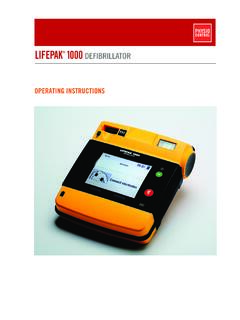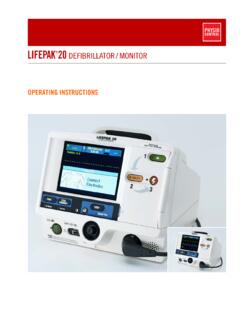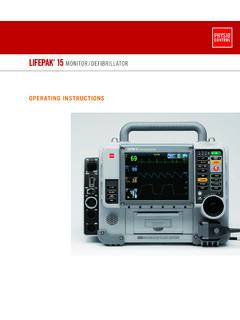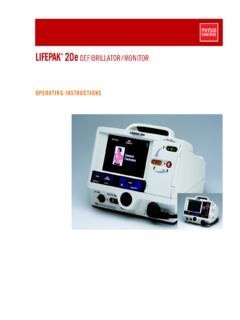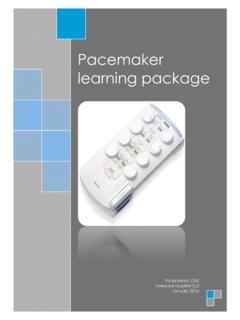Transcription of OPERATING INSTRUCTIONS - Stryker Emergency Care
1 +LIFEPAK CR PlusDEFIBRILLATORLIFEPAK EXPRESS DEFIBRILLATOROPERATING INSTRUCTIONSLIFEPAK CRPlus DEFIBRILLATOR LIFEPAK EXPRESS DEFIBRILLATOR OPERATING INSTRUCTIONSR esponsibility for InformationIt is the responsibility of our customers to ensure that the appropriate person(s) who may use this defibrillator have access to the information in this manual, including general safety information provided in Section OnlyDevice TrackingThe Food and Drug Administration requires defibrillator manufacturers and distributors to track the location of their defibrillators. If the device is located somewhere other than the shipping address or the device has been sold, donated, lost, stolen, exported, destroyed, permanently retired from use, or if the device was not obtained directly from Physio-Control, please do one of the following: register the device at , call the device tracking coordinator at , or use one of the postage-paid address change cards located in the back of this manual to update this vital tracking HistoryThese OPERATING INSTRUCTIONS describe the LIFEPAK CR Plus and LIFEPAK EXPRESS defibrillators with software Version or later.
2 !USA!USALIFEPAK, LIFEPAK CR, LIFEPAK EXPRESS, and QUIK-COMBO are registered trademarks of Physio-Control, Inc. ADAPTIV, CODE-STAT, CHARGE-PAK, QUIK-PAK, and Shock Advisory System are trademarks of Physio-Control, Inc. IrDA is a registered trademark of Infrared Data Association. Specifications are subject to change without notice. 2009 Physio-Control, Inc. All rights 3201686-011 Publication Date: 1/2009 LIFEPAK CR Plus and LIFEPAK EXPRESS Defibrillator OPERATING Instructionsiii 2009 Physio-Control, OF CONTENTS11 IntroductionAbout Automatic External Defibrillators .. 1-2 Indications for 1-2 Contraindications .. 1-2 Why the Need for Defibrillators .. 1-2 Terminology .. 1-3 Text Conventions .. 1-4 Safety Information .. 1-4 Safety Terms .. 1-4 General Warnings and Cautions ..1-5 Symbols .. 1-7 About the LIFEPAK CR Plus and LIFEPAK EXPRESS Defibrillators.
3 1-9 Capabilities and 1-102 Getting StartedUnpacking and Inspecting Your LIFEPAK CR Plus or LIFEPAK EXPRESS Defibrillator .. 2-2 Where to Locate Your LIFEPAK CR Plus or LIFEPAK EXPRESS defibrillator .. 2-3 Controls, Indicators, and Labels .. 2-4 Outside Controls, Indicators, and Labels .. 2-4 Inside 2-53 Using the DefibrillatorWarnings and Cautions .. 3-2 Responding to a Sudden Cardiac Arrest Emergency .. 3-2 Basic Steps for Using the LIFEPAK CR Plus or LIFEPAK EXPRESS 3-3 What to Do After Emergency Medical Personnel 3-5 What to Do After Using Your Defibrillator .. 3-5 Voice INSTRUCTIONS and Tones .. 3-5 Troubleshooting .. 3-6ivLIFEPAK CR Plus and LIFEPAK EXPRESS Defibrillator OPERATING Instructions4 Data StorageOverview of Data Storage .. 4-2 Data Stored by Your Defibrillator .. 4-2 Test and Service Data.
4 4-2 Event and Test 4-35 Caring for Your DefibrillatorMaintaining a State of Readiness .. 5-2 Storing Your Defibrillator .. 5-2 Cleaning Your Defibrillator .. 5-2 Replacing the CHARGE-PAK Battery Charger and the QUIK-PAK Electrode Packet .. 5-4 Replacing the CHARGE-PAK Battery Charger .. 5-5 Replacing the QUIK-PAK Electrode 5-7 Obtaining Authorized Service .. 5-8 Recycling Information .. 5-8 Recycling Assistance .. 5-8 Recycling of Disposable Electrodes .. 5-8 Supplies, Accessories, and Training Tools .. 5-8 Warranty Information .. 5-86 Defibrillator OPERATING SettingsOperating Settings and Setup Configuration .. 6-2A SpecificationsB Shock Advisory SystemC User s ChecklistD Electromagnetic Compatibility GuidanceIndexLIFEPAK CR Plus and LIFEPAK EXPRESS Defibrillator OPERATING Instructions1-1 2009 Physio-Control, IntroductionINTRODUCTION1 This section provides background information about defibrillation and includes an overview of LIFEPAK CR Plus and LIFEPAK EXPRESS defibrillator Automatic External Defibrillatorspage 1-2 Safety Information1-4 Symbols1-7 About the LIFEPAK CR Plus and LIFEPAK EXPRESS Defibrillators1-91-2 LIFEPAK CR Plus and LIFEPAK EXPRESS Defibrillator OPERATING InstructionsIntroductionABOUT AUTOMATIC EXTERNAL DEFIBRILLATORSThe LIFEPAK CR Plus and LIFEPAK EXPRESS defibrillators are automated external defibrillators (AEDs).
5 For many years, defibrillators have been used only by medical professionals to treat victims in sudden cardiac arrest (SCA). Today, the ability of defibrillators to save lives is so widely recognized that people once trained to do only cardiopulmonary resuscitation (CPR) can now use electrode pads are applied to the victim s chest, the defibrillator analyzes the victim s heart rhythm . If a shockable rhythm is detected, the defibrillator will either deliver an intense pulse of electricity (shock) to the heart muscle (fully automatic model) or direct the responder to deliver the shock (semiautomatic model). The defibrillator delivers shocks through the electrode pads on the victim s this pulse of electricity is delivered, it is called defibrillation. Defibrillation is recognized for treating life-threatening heart beat irregularities, such as ventricular fibrillation, that cause LIFEPAK CR Plus and LIFEPAK EXPRESS defibrillators are designed specifically for infrequent use and for use by people whose only training is in CPR and in using for UseThe LIFEPAK CR Plus and LIFEPAK EXPRESS defibrillators are indicated for use on patients in cardiac arrest.
6 The patient must be unresponsive (unconscious), not breathing normally, and showing no signs of circulation (for example, no pulse, no coughing, or no movement). With Infant/Child Reduced Energy Defibrillation Electrodes, the LIFEPAK CR Plus and LIFEPAK EXPRESS defibrillators may be used on children who are up to 8 years old or who weigh up to 25 kg (55 lb).ContraindicationsNone the Need for DefibrillatorsThe American Heart Association estimates that, in the USA alone, at least 250,000 people die each year of cardiac arrest. Of these, about 10,000 people might have been saved had they received immediate treatment from a defibrillator. Sudden cardiac arrest is usually caused by a malfunction in the heart s electrical system. Called ventricular fibrillation, this critical condition prevents the heart from pumping blood throughout the body.
7 Ventricular fibrillation can cause death within is a relatively simple procedure that involves placing electrode pads on a victim s exposed chest and delivering an electrical shock to the heart. The externally-delivered shock often restores the heart s electrical system to normal rhythm . Combined with CPR, defibrillation provides the most effective care for victims in cardiac CR Plus and LIFEPAK EXPRESS Defibrillator OPERATING Instructions1-3 2009 Physio-Control, IntroductionIntroductionTerminologyThe following terms appear in this External Defibrillator. A device that evaluates the victim s heart rhythm and delivers an electrical shock to the heart if a shockable rhythm is arrestThe termination of the heart s pumping action resulting in the lack of a heartbeat or pulse and resuscitation.
8 This involves delivering rescue breathing and chest compressions to a victim in cardiac of an electrical shock to the heart for the purpose of reversing ventricular A composite picture of what is occurring electrically in the activity of the heart s electrical system. This condition can occur in the atria or the ventricles. When it occurs in the ventricles, they quiver in a rapid, chaotic manner, preventing them from pumping blood to the body. Heart attackA nonspecific term referring to the death of heart muscle resulting from interruption of blood supply, often confused with cardiac to the flow of electrical current through the basic unit of energy delivered by a emitting infarctionThe specific term for what is usually meant by heart attack; death of heart muscle resulting from an interruption of the blood supply to that area of rhythmA heart rhythm that is detected by the defibrillator that does not need a shock, but may need this manual, the person suffering from cardiac this manual, the person giving aid to a victim in cardiac arrest.
9 Used interchangeably with patented Shock Advisory System . Shockable rhythmA heart rhythm that is detected by the defibrillator as requiring a shock, for example, ventricular this manual, the person giving aid to a victim in cardiac arrest. Used interchangeably with fibrillationA life-threatening chaotic heart tachycardia Rapid heart rhythm originating in the CR Plus and LIFEPAK EXPRESS Defibrillator OPERATING InstructionsIntroductionText ConventionsThroughout this manual, special text characters are used to indicate labels and voice INSTRUCTIONS : OPERATING control labels: CAPITAL LETTERS such as ON/OFF and ce INSTRUCTIONS : ITALICIZED CAPITAL LETTERS such as STAND INFORMATIONThis section provides important information to help you safely operate your defibrillator. Familiarize yourself with all of the terms, warnings, and symbols presented in this section.
10 Safety TermsYou may encounter the following terms in this manual and while using your defibrillator:DangerImmediate hazards that will result in serious personal injury or death to the user and/or the or unsafe practices that could result in serious personal injury or death to the user and/or the or unsafe practices that could result in minor personal injury to the user and/or the victim, product damage, or property CR Plus and LIFEPAK EXPRESS Defibrillator OPERATING Instructions1-5 2009 Physio-Control, IntroductionIntroductionGeneral Warnings and CautionsWARNINGS!Shock defibrillator delivers up to 360 joules of electrical energy. Unless properly used as described in this manual, this electrical energy may cause serious injury or death. Do not attempt to operate this defibrillator unless thoroughly familiar with this manual and the function of all controls, indicators, connectors, and not insert a finger or any object other than the CHARGE-PAK into the well of the or fire not immerse any portion of this defibrillator in water or other fluids.
